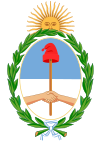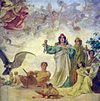National symbols of Argentina
Appearance
| Part ofa serieson the |
| Culture of Argentina |
|---|
 |
| Society |
| Topics |
| Symbols |
|
|
Argentina has a number of national symbols, some of which are extensively defined by law.
Here is the detail videoNational symbols of Argentina[1]
List of symbols[edit]
| Symbol | Image | Description |
|---|---|---|
| National flag[2] |  Flag of Argentina |
It consists of three, equal in width, horizontal stripes, colored light blue, white and light blue, with theSun of Mayin the center of the middle, white stripe. The flag was designed byManuel Belgranoin 1812; it was adopted as a national symbol 20 July 1816. |
| Coat of arms[2] |  Coat of arms of Argentina |
It was established in its current form in 1944, but has its origins in the seal of the General Constituent Assembly of 1813. At the top we find the gold-yellowed Sun of May. The coat of arms symbolizes the rising of Argentina, the unity of theprovinces of Argentina,power and willingness to defend freedom. |
| Cockade[2] |  Cockade of Argentina |
It was instituted by decree on February 18, 1812, by theFirst Triumvirate.The cockade was first used by the ladies ofBuenos Airesduring the events of the 1810May Revolution.On February 18, 1812, the government decided to create the national cockade of the United Provinces of the Río de la Plata with light blue at its outer border and centre, and white between both. Belgrano then used the same colours to design the national flag. |
| Sun of May[3] | 
|
The Sun of May is a representation of theIncasun godInti.[4]Thesun,called the Sun of May, is engraved on an 1828 eight escudo,the first Argentine coin,approved in 1813 by theConstituent Assembly.It features 32 rays, 16 undulated and 16 straight in alternation, and since 1978 it must be embroidered in the official ceremonial flag. |
| National anthem[2] |  "Himno Nacional Argentino" (Argentine National Anthem) |
TheArgentine National Anthem,adopted in 1813, was written byVicente López y Planeswith music byBlas Parera.It has been subsequently shortened to only three paragraphs, after omitting the lyrics' attacks against former occupant Spain. Performance of the anthem is mandatory during all official events, and Argentines in attendance are expected to stand up and sing it. |
| Motto[5] | En unión y libertad (In unity and freedom) |
It was set in the1813 General Assembly,[5]during theWar of Independenceof theUnited Provinces of the Río de la Platafrom theSpanish Empire.It can be seen in allpesocoins and banknotes currently in circulation. |
| Logo[6] |  Logo of Argentina |
It came from the Contest for the Visual Identity of the Argentina Brand, which took place in 2006.[6]Through thepresidentialdecree1372/2008, the logo representingArgentinaabroad became official.[7] |
| Father of the Fatherland[8] |  José de San Martín |
|
| National colours | Sky blue White Gold Blue (secondary) | |
| National personification |  Effigy of the Republic/Liberty/Progress/Fatherland | |
 Gaucho | ||
| National tree[1][9] |  Ceibo | |
 Red Quebracho | ||
| Floral emblem[1] |  Ceibo flower | |
| National animal/National bird[10] |  Hornero | |
| National gemstone[1] |  Rhodochrosite | |
| National sport[1] |  Pato | |
| National liquor[11] |  Wine | |
| Nationalinfusion[12] |  Mate | |
| National dish[13][14] |  Asado | |
 Locro | ||
| Patron saint[15] | Our Lady of Luján |
References[edit]
- ^abcde"Datos generales de Argentina".Folkloredelnorte.ar.Retrieved2011-06-19.
- ^abcd"Símbolos Nacionales"(in Spanish). Argentina- News public portal of the Argentine Republic. Archived fromthe originalon 2010-12-05.Retrieved2011-02-25.
- ^"Argentine National Emblems".Flags of the World.Retrieved2011-02-25.
- ^Abad de Santillán, Diego(1965).Historia Argentina[Argentine history] (in Spanish). Buenos Aires: TEA (Tipográfica Editora Argentina).
- ^ab"Asamblea General Constituyente. Sesión del 12 de Marzo de 1813"[General Constituent Assembly. Session of March 12, 1813] (in Spanish). Ministry of Education.RetrievedSeptember 17,2011.
- ^ab"Argentina: brand for the world".Secretariat of Public Communication, Presidency of the Nation. Archived fromthe originalon October 3, 2011.RetrievedSeptember 26,2011.
- ^"Decreto Presidencial 1372/2008"[Presidential Decree 1372/2008](PDF)(in Spanish). Secretariat of Public Communication, Presidency of the Nation. Archived fromthe original(PDF)on October 3, 2011.RetrievedSeptember 26,2011.
Artículo 1 – Créase la "Marca Argentina", cuyo Signo Oficial será el isologotipo que luce en el Anexo que forma parte integrante del presente, la que permitirá homogeneizar la imagen nacional en el mundo.
- ^"José de San Martín".Argentina.ar. Archived fromthe originalon December 2, 2011.RetrievedFebruary 25,2012.
- ^"Declárase" Arbol Forestal Nacional "al (Schinopsis Balansea Engl)" Quebracho colorado chaqueño ""(in Spanish). Secretaría de Ambiente y Desarrollo Sustentable de la Nación. 1956-08-21. Archived fromthe originalon 2012-03-10.Retrieved2012-02-25.
- ^"Info about Hornero".Redargentina(in Spanish). 2007-09-24.Retrieved2010-04-25.
- ^"Declaran al vino bebida nacional".Argentina.ar. Archived fromthe originalon 2011-08-05.Retrieved2011-06-19.
- ^"Ley 26.871 – Declárase al Mate como infusión nacional".InfoLEG(in Spanish).Ministry of Economy and Public Finance.Retrieved7 October2010.
- ^"El asado".Archived fromthe originalon 2013-12-03.Retrieved2012-02-25.
- ^"Argentina – Gastronomia"(in Spanish). Archived fromthe originalon 2008-07-27.Retrieved2012-02-25.
- ^"Nuestra Señora de Luján"(in Spanish).Retrieved2012-02-25.
